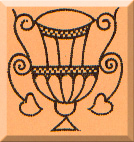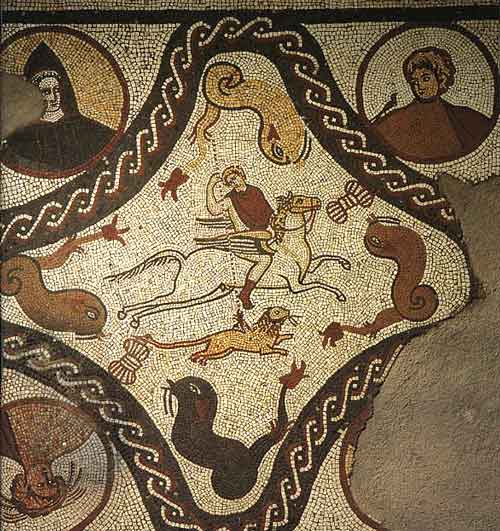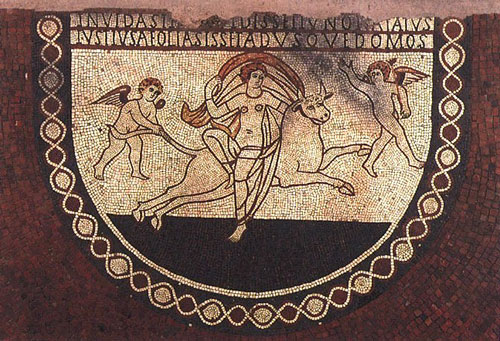
 |
ASPROM | |||||||||||||||||||
The Association for the Study and Preservation of Roman Mosaics |
||||||||||||||||||||
| About ASPROM | News & Events | Publications | Mosaics in Britain | Resources | Join ASPROM | |||||||||||||||
 |
| Mosaic in Lullingstone Villa (photo by David S. Neal). |
The dining room or triclinium was enlarged in the mid-fourth century AD by the construction of a large semi-circular extension (apse). The triclinium and the apsed room were then paved with mosaic.
 |
| Lullingstone Villa: triclinium mosaic (photo by David S. Neal). |
Bellerophon is riding the winged horse Pegasus. The Chimaera, a fire-breathing monster, had a lion's head, the head of a goat rising from its back, and a serpent's tail. In the same panel are four bulbous-looking dolphins and two dumbbell-shaped objects which represent open shells.
In the corners of the central panel are roundels with representations of the Four Seasons. Spring has a swallow on her right shoulder, summer is depicted with ears of corn. The panel depicting Autumn is lost. Winter is hooded. Separating the two mythical scenes is a geometric design based on a series of squares, octagons and crosses containing a variety of motifs. In most of the octagons are heart-shaped petals. Swastikas, originally a good luck symbol, occupy some of the squares, but can also be seen in the Greek key-pattern border.
 |
| Lullingstone Villa: scene of Europa and the bull in the apse (photo by David S. Neal). |
This mosaic is accompanied by a couplet which refers to a passage in the Aeneid of the poet Vergil. Jupiter, in the guise of a spirited bull, has abducted Europa, who sits on his back, unconcerned for her fate, looking attractive in a diaphanous dress. She is accompanied by a pair of cupids, one of whom tries to prevent the rape by holding onto the bull's tail.
The Latin couplet, translated, reads:
'If jealous Juno had seen the swimming of the bull she would with greater justice on her side have repaired to the halls of Aeolus'
This is an allusion to the first book of the Aeneid, where Juno, the wife of Jupiter, persuades the god of the winds, Aeolus, to raise a storm to overwhelm Aeneas on his voyage to Italy. On the mosaic the sea is represented by an area of dark blue tesserae. The scene demonstrates clearly that the owner of the villa was literary and read Latin, for the cautionary couplet would have been meaningless to anyone who did not know the works of Vergil.
The mosaic is well made and the scene of Europa cleverly depicted in a simple, yet effective linear style. The work of the Bellerophon panel is similar, but the mosaicist has made a poor representation of the Chimaera and appears not to have understood that the head rising from its back should have been a goat's. There are a number of errors in the pattern. At the south-east corner the Greek key border is not continuous and not all the octagons in the geometric panel have heart-shaped motifs; some, for example, have chequers and a single example on the south side has a small jug or cantharus.
| © David S. Neal 1997. |